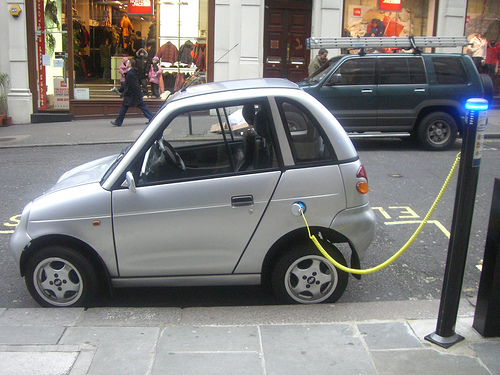(This article was published in Spanish in Cotizalia in June 2011)
There are few examples in the industrial history of a bigger disaster of planning than that of the electric car. Armed with all the potential to be a success, the greed of some, seeking crazy subsidies and the lack of innovation of others have made the project derail into almost an anecdotal episode in business and technology.
In 2009 I wrote here that the expectations of the EU and US governments of electric vehicle sales were simply impossible. The electric vehicle was not killed by the oil companies.
Here is the list of the murder suspects:
a) The Car Renewal Plans and the automotive sector bail-outs/subsidies. In this society of overcapacity-filled industries addicted to subsidies, governments rushed to defend the electrification of transport while rescuing the conventional car industry with billions in public funds. The aids given by the EU and US to buy a new car, and reduce the brutal inventory of unsold combustion engine vehicles, exceeded by 6 to 1 the amount devoted for electric car developments. Furthermore, the auto industry, a sector doomed because a model that does not work if the consumer doesn’t change his or her car every three years.
This has forced the absorption of inventory and accelerated fleet renewal, reducing any potential for electric cars in the next five years. Today some EU countries have announced with fanfare an aid to electric car purchases which is less than 10% of what consumers received to renew their car, and that helped the auto industry sell unsold inventory of SUVs. As an annecdote, 2010 was the year of highest sales of SUVs since 2006.
b) Scandalous Pricing. An electric car, which seeks to replace part of the combustion engine vehicles, cannot succeed if it sells at an average of 50% higher than the alternative. This concept of promoting expensive alternatives is pretty bull market, not for a realistic economy. Alternatives will only exist if they are more attractive, cheaper and efficient.
c) Designed by the enemy. “God, how awful,” was the comment of my female coworkers when we brought several models to test to our offices. If the design of a car is not attractive for 50% of its potential market, and the most important segment at that, forget it.
d) The tax effect. The Spanish state collects €17.5 billion in taxes from petrol and diesel, where the tax rate is 55-60%. At the EU level that figure exceeds the €250bn mark, with taxes on petrol that range between 40% and 65%. No one escapes from taxation, and this has been discussed in several forums: If the electric vehicle takes a significant percentage of market share, the states will transfer the gasoline-diesel tax to power, and the current calculations of savings that electric vehicle defenders claim, would be slashed to be virtually non-existent.
e) A wrong model. With the electric car, where the most important is upfront cost and battery life, the industry has made the mistake of replicating exactly the model of the traditional car, where the buyer takes all the technology, battery and maintenance risk for no discernible cost benefit. The only company that has innovated is Better Place, which offers a service that is similar to mobile phones, giving a full package of battery maintenance, service and charge. However, it is debatable if that model would be easily transferred from the current countries where it is implemented, Israel and Denmark, to bigger countries with more population density and scattered cities, in the rest of the world.
f) Although battery prices have dropped up to 38%, manufacturing costs have remained almost stable, which suggests that the supposed benefits in cost of batteries from technology developments will fade away, to be prohibitively expensive again, once the current overcapacity in battery production systems is reduced.
g) Subsidies to power, including renewables, but also coal and gas, have made the average cost of electricity rise for consumers all over the EU. If we add that the autonomy of electric cars is very limited, the consumer does not have a clear benchmark for cost-effectiveness compared with its current alternative. Furthermore, in a combustion engine car if the driver sees that the price of gasoline is expensive, the choice to reduce consumption is immediate and personal. But in an electric vehicle, if the battery remains discharged for a long time its performance worsens, and the choice of “not charging” if power prices soar is not available.
h) It is assumed that the electric car is charged at night when electricity demand is in the “valley” (minimum consumption) level and is cheaper … Until, oh surprise, you have 1 or 2 million cars charging at the same time… and then night charging is neither cheap nor demand is in valley.
Finally … As for being green, electric vehicles are not truly green, because of the contamination of thousands of tons of water that the production of rare earths entails (although we seem to care little, as its contamination in China, not at home). Furthermore, now that the EU is anti-nuclear, power generation with coal and gas has soared, neither of which is “green” or cheap.
We mentioned Better Place before, a company led by Shai Agassi, an Israeli entrepreneur who understood perfectly that the model for success with the electric car could not be the one of the traditional car industry, because consumers would be exposed to the same risks of maintenance and cost inflation, if not more.
Thus in Denmark and Israel Better Place offers an innovative system in which the company runs all costs (charging, battery change, service and network connections) and the consumer leases the vehicle based on their needs, without having to take the replacement risk and cost of the battery.
This reduces the enormous costs to the consumer both in the acquisition of batteries, and prevents them from enduring the hassle of maintenance and replacement. More importantly, Better Place does this without subsidies. A good initiative.
Further read:
http://energyandmoney.blogspot.com/2009/12/observations-on-arrival-of-electric-car.html

